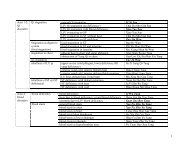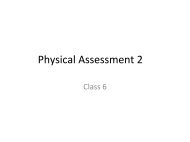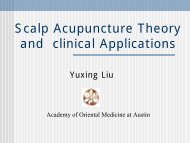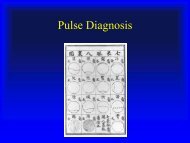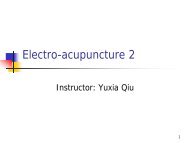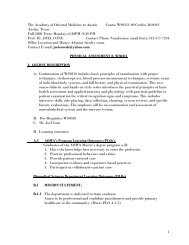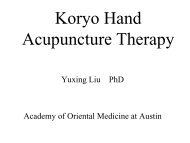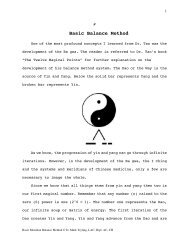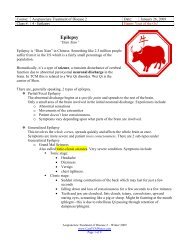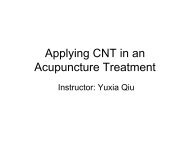SCALP ACUPUNCTURESCALP ACUPUNCTURE - CatsTCMNotes
SCALP ACUPUNCTURESCALP ACUPUNCTURE - CatsTCMNotes
SCALP ACUPUNCTURESCALP ACUPUNCTURE - CatsTCMNotes
You also want an ePaper? Increase the reach of your titles
YUMPU automatically turns print PDFs into web optimized ePapers that Google loves.
<strong>SCALP</strong> <strong>ACUPUNCTURE</strong><br />
The International<br />
Standard Scheme for<br />
Scalp Acupuncture<br />
XIAOTIAN SHEN L.Ac
<strong>SCALP</strong> <strong>ACUPUNCTURE</strong><br />
General Introduction &<br />
schools of scalp acupuncture<br />
A Brief History<br />
In the ancient time<br />
50’s<br />
70’s<br />
May 1984, November 1989
<strong>SCALP</strong><br />
Regional Anatomy<br />
Structure: 5 layers<br />
The soft tissue envelope of the<br />
cranial vault is called the scalp. The<br />
scalp extends from the external<br />
occipital protuberance and superior<br />
nuchal lines to the supraorbital<br />
margins. The scalp consists of 5<br />
layers: the skin, connective tissue,<br />
epicranial aponeurosis, loose areolar<br />
tissue, and pericranium. The first 3<br />
layers are bound together as a single<br />
unit. This single unit can move along<br />
the loose areolar tissue over the<br />
pericranium, which is adherent to the<br />
calvarium.
<strong>SCALP</strong><br />
The scalp is made<br />
of 5 layers and<br />
they spell<br />
<strong>SCALP</strong>:<br />
S -- skin<br />
C -- connective<br />
tissue<br />
A – aponeurosis<br />
epicranialis<br />
L -- loose<br />
connective<br />
tissue<br />
P -- pericranium
<strong>SCALP</strong><br />
Sensory supply<br />
Six sensory nerve branches of either the trigeminal nerve or<br />
the cervical nerve supply the scalp.<br />
The supratrochlear nerve is a branch of the ophthalmic<br />
division of the trigeminal nerve. This nerve supplies the<br />
scalp in the medial plane at the frontal region up to the<br />
vertex.<br />
The supraorbital nerve is also a branch of the ophthalmic<br />
division of the trigeminal nerve. This nerve supplies the<br />
scalp at the front, lateral to the supratrochlear nerve<br />
distribution, up to the vertex.<br />
The zygomaticotemporal nerve is a branch of the<br />
maxillary division of the trigeminal nerve and supplies<br />
the scalp over the temple region.<br />
The auriculotemporal nerve is a branch of the<br />
mandibular division of the trigeminal nerve and supplies<br />
the skin over the temporal region of the scalp.<br />
The lesser occipital nerve is a branch of the cervical<br />
plexus (C2), which supplies the scalp over the lateral<br />
occipital region.<br />
The greater occipital nerve is a branch of the posterior<br />
ramus of the second cervical nerve. This nerve supplies<br />
the scalp in the median plane at the occipital region up to<br />
the vertex.
Arterial supply<br />
<br />
<br />
<br />
<br />
<br />
The scalp has a rich vascular supply. The blood vessels<br />
traverse the connective tissue layer, which receives<br />
vascular contribution from the internal and external<br />
carotid arteries. The blood vessels anastomose freely in<br />
the scalp. From the midline anteriorly, the arteries present<br />
as follows: supratrochlear, supraorbital, superficial<br />
temporal, posterior auricular, and occipital.<br />
The supratrochlear and supraorbital arteries are<br />
2 branches of the ophthalmic artery, which, in<br />
turn, is a branch of the internal carotid artery.<br />
These arteries accompany the corresponding<br />
nerves.<br />
The superficial temporal artery is a terminal<br />
branch of the external carotid artery that<br />
ascends in front of the auricle. This artery, which<br />
supplies the scalp over the temporal region,<br />
travels with the auriculotemporal nerve and<br />
divides into anterior and posterior branches.<br />
The posterior auricular artery is a branch of the<br />
external carotid artery that ascends posterior to<br />
the auricle.<br />
The occipital artery is a branch of the external<br />
carotid artery. It is accompanied by the greater<br />
occipital nerve.
Venous drainage<br />
<br />
<br />
<br />
<br />
The veins of the scalp freely anastomose with one<br />
another and are connected to the diploic veins of the<br />
skull bones and the intracranial dural sinuses through<br />
several emissary veins. The emissary veins are<br />
valveless. The veins of the scalp accompany the<br />
arteries and have similar names.<br />
The supratrochlear and supraorbital veins drain<br />
the anterior region of the scalp. These 2 veins unite<br />
to form the angular vein at the medial angle region<br />
of the eye and continue further as the facial vein.<br />
The superficial temporal vein descends in front of<br />
the auricle and enters the parotid gland. It joins the<br />
maxillary vein to form the retromandibular vein.<br />
The anterior division of the retromandibular vein<br />
unites with the facial vein to form the common<br />
facial vein, which then drains into the internal<br />
jugular vein.<br />
The posterior auricular vein joins the posterior<br />
division of the retromandibular vein to form the<br />
external jugular vein.<br />
The occipital vein terminates in the suboccipital<br />
venous plexus, which lies beneath the floor of the<br />
upper part of the posterior triangle.
The Channels to the Head<br />
There’re 8<br />
channels going<br />
up to the head<br />
directly:<br />
BL<br />
SJ<br />
GB<br />
ST<br />
LV<br />
DU<br />
Yangwei<br />
Yangqiao<br />
There’re 6<br />
channels<br />
reaching the<br />
face:<br />
LI<br />
SI<br />
Ht<br />
Ren<br />
Chong<br />
Yinqiao
Point Location Refreshment<br />
Du-24<br />
BL-3<br />
GB-14<br />
GB-15<br />
St-8<br />
Du-20<br />
Du-21<br />
Si Shen Cong<br />
GB-7<br />
GB-6<br />
BL-7<br />
GB-17<br />
GB-16<br />
GB-18<br />
GB-4<br />
D-17<br />
D-18<br />
BL-9<br />
BL-10
GB-15: 0.5<br />
GB-16: 1<br />
BL-3: 0.5<br />
BL-4: 0.5<br />
BL-5: 1<br />
BL-6: 2.5<br />
BL-8: 5.5<br />
(cun)<br />
GB-17: 2.5<br />
GB-18: 4<br />
Distance form Anterior Hair Line<br />
Distance form Anterior Hair Line
Scheme for Scalp Acupuncture<br />
The International Standard<br />
There’re 14 locations of scalp<br />
lines, 25 lines in total<br />
3 single lines (middle lines)<br />
11 pairs of lines (symmetric)<br />
General locations of the lines<br />
Forehead area: 4 locations, 7 lines:<br />
MS1-4<br />
Vertex area: 5 locations, 9 lines:<br />
MS5-9<br />
Temple area: 2 locations, 4 lines:<br />
MS10 & 11<br />
Occipital area: 3 locations, 5 lines:<br />
MS 12-14
Gauge: # 30 (0.32mm), #32<br />
(0.25mm), #34 (0.22mm), #36<br />
(0.20mm), #38 (0.18mm)<br />
Length: 1 cun, 1.5 cun<br />
Needles for Scalp Acupuncture<br />
Needles for Scalp Acupuncture
Positioning<br />
Position of the patient<br />
Position of the practitioner
Wash the hair<br />
Separate hair<br />
2% iodine<br />
70% alcohol<br />
CNT for Scalp Acupuncture<br />
CNT for Scalp Acupuncture
Depth<br />
Angle<br />
Needling<br />
Sensations<br />
Needle Insertion<br />
Needle Insertion
Pressure<br />
Soreness<br />
Heaviness<br />
Distention<br />
Cool sensation<br />
Warm sensation<br />
Normal Needling Sensations<br />
Normal Needling Sensations
Needle Retention and<br />
Manipulation<br />
Withdrawal<br />
Acupressure on scalp<br />
Electrical acupuncture on scalp<br />
Precautions<br />
More About Needling Techniques<br />
More About Needling Techniques
Manipulations<br />
After the arrival of Qi,<br />
manipulate the needles during<br />
retention every 10-15 minutes.<br />
Rotate a needle at small<br />
amplitude but rapid (about 200<br />
twists per minute) for 1 – 3<br />
minutes.
Precautions<br />
No scalp acupuncture on infants<br />
whose fontanel is not closed, or a<br />
patient with injury or post operative<br />
wound or tumor.<br />
For the patients at acute stage of<br />
cerebral hemorrhage, heart failure and<br />
weak constitution, scalp acupuncture<br />
should be used with caution.<br />
Avoid scars, sores and hair follicles.<br />
During the treatment, watch the<br />
patient closely to avoid acushock.<br />
Prevent bleeding on withdrawal.<br />
Always count the needles.
Reinforcing and reducing<br />
Reducing method: after inserting a<br />
needle into the loose connective<br />
tissues, lift the needle forcefully in 3<br />
rapid motions, then thrust the needle<br />
back gently.<br />
Reinforcing method: after inserting a<br />
needle into the loose connective<br />
tissues, thrust the needle forcefully in<br />
3 rapid motions, then lift the needle<br />
back gently.<br />
Reinforcing and reducing along or<br />
against a channel:<br />
MS-1, MS-5, MS-2, MS-3, MS-8,<br />
MS-9, MS-10, MS-11, MS-12, MS-<br />
14
Other Needling Tchniques<br />
Opposite needling:<br />
Up Down: MS-1, 2, 3, 4,<br />
12, 13, 14<br />
Back Forth: MS-5, 8, 9<br />
Threading method: MS-6<br />
and 7, MS-12 and 13<br />
Relay needling: multiple<br />
needles to cover a long line<br />
Triple needling: \|/<br />
MS-1, 5, 12, Du-20 (Y),
Chose Side<br />
For disorders above the neck,<br />
needle scalp lines on the same<br />
side<br />
For disorders below the neck,<br />
needle the opposite side<br />
For disorders on both sides,<br />
needle the lines bilaterally<br />
For interior or general disorders<br />
(i.e., reproductive diseases,<br />
digestive problems, etc.,) needle<br />
bilaterally.
Locations and functions of<br />
Locations and functions of<br />
Scalp Lines Scalp Lines
MS1 Middle Line of Forehead<br />
(Ezhongxian)<br />
1 cun long from DU24 Shengting<br />
straight down along the meridian.<br />
Indications:<br />
psycho-emotional disorders<br />
nasal disorders
MS2 Lateral Line 1 of Forehead<br />
(Epangxian I)<br />
1 cun long from BL3 Meichong<br />
straight down along the meridian.<br />
Indications:<br />
Disorders in the upper-jiao<br />
Disorder of nose
MS3 Lateral Line 2 of – Forehead<br />
(Epangxian II)<br />
1 cun long from GB15 Toulinqi<br />
straight down along the meridian.<br />
Indications:<br />
Disorders in the middle-jiao,<br />
Disorder of eyes
MS4<br />
Lateral Line 3 of Forehead<br />
(Epangxian III)<br />
1 cun long from the point 0.75<br />
cun medial to ST8 Touwei<br />
straight down.<br />
Indications:<br />
disorders in the lower-jiao,<br />
(1) gynecological diseases,<br />
(2) male’s reproductive disorders,<br />
(3) urinary disorders<br />
Disorder of eyes
MS5 Middle Line of Vertex<br />
(Dingzhongxian)<br />
From DU20 Baihui to DU21<br />
Qianding along the midline of<br />
head.<br />
Indications:<br />
diseases in the region lower than<br />
the waist<br />
mental disorders and emotional<br />
diseases<br />
prolapsed rectum or uterus<br />
local pain: pain in the vertex<br />
region
MS6 Anterior Oblique Line of Vertex-Temporal<br />
(Dingnie Qianxiexian)<br />
From Qianshencong (one of acupuncture<br />
points of Ex-HN1 Sishencong, 1 cun<br />
anterior to DU2O Baiihui obliquely to<br />
GB6 Xuanli.<br />
Indications:<br />
mobility impairment:<br />
upper section (upper 1/5 of the line ): paralysis,<br />
dyscinesia in the trunk and lower limbs;<br />
middle section (middle 2/5 of the line) : dyscinesia<br />
in the upper limbs;<br />
lower section (lower 2/5 of the line) : dyscinesia<br />
in the head and face, central facial paralysis,<br />
aphemia, anaudia, salivation, central<br />
arteriosclerosis, etc.
MS7 Posterior Oblique Line of<br />
Vertex-Temporal<br />
(Dingnie Houxiexian)<br />
From DU20 Baihui obliquely to GB7<br />
Qubin.<br />
Indications:<br />
sensation impairment:<br />
(1) upper section (upper 1/5 of the line):<br />
formication, paresthesia and sensory<br />
disturbance in the trunk and lower limbs;<br />
(2) middle section (middle 2/5 of the line) :<br />
sensory impairment in the upper limbs;<br />
(3) lower section (lower 2/5 of the line) :<br />
sensory impairment in the head and face
MS8 Lateral Line 1 of Vertex<br />
(Dingpangxian I)<br />
1.5 cun lateral to Middle Line<br />
of Vertex, 1.5 cun long from<br />
BL7 Tongtian , backward along<br />
the meridian. (From BL7<br />
Tongtian to BL-8 Luoque)<br />
Indications: diseases and<br />
symptoms of the waist and legs,<br />
such as paralysis, numbness,<br />
pain, etc.
MS9 Lateral Line 2 of Vertex<br />
(Dingpangxian II)<br />
2.25 cun lateral to Middle Line<br />
of Vertex, 1.5 cun long from<br />
GB17 Zhengying backward<br />
along the meridian. (From GB-<br />
17 Zhnegying to GB-18<br />
Chengling)<br />
Indications: diseases and<br />
symptoms of the shoulders, arms<br />
and hands, such as paralysis,<br />
numbness, pain, etc.
MS10 Anterior Temporal Line<br />
(Nieqianxian)<br />
From GB4 Hanyan to GB6<br />
Xuanli.<br />
Indications: Disorders of head,<br />
face and neck.
MS11 Posterior Temporal Line<br />
(Niehouxian)<br />
From GB8 Shuaigu to GB7<br />
Qubin.<br />
Indications:<br />
Dizziness, vertigo<br />
Disorders of ears
MS12 Upper-Middle - Line of<br />
Occiput<br />
(Zhenshang Zhengzhongxian)<br />
From DU18 Qiangjian to DU17<br />
Naohu.<br />
Indications: eye diseases:<br />
inflammations in the eyes, keratitis,<br />
and conjunctivitis.
MS13 Upper-Lateral Line of Occiput<br />
(Zhenshang Pangxian)<br />
0.5 cun lateral and parallel to Upper-<br />
Middle Line of Occiput (MS-12).<br />
Indications: cortical visual<br />
disturbance
MS14 Lower-Lateral Line of Occiput<br />
(Zhengnxia Pangxian)<br />
2 cun long from BL9 Yuzhen straight<br />
down. (From BL9 to BL10 TianZhu)<br />
Indications:<br />
cerebella diseases (cerebella injury or<br />
atrophy),<br />
pain in the occipital region and nape.
Clinic Applications<br />
Stroke<br />
Restore sensation and motility<br />
Improve muscle tones<br />
MS-5, 6,7, 8, 9<br />
Retain the needles and exercise, 2-4 hrs<br />
Acute stage: daily treatment for 10 days<br />
Recovery stage: once or twice a week for 3<br />
months.<br />
Prognosis:<br />
Paralysis caused by (cerebral) thrombosis<br />
recovers better than embolism and<br />
hemorrhage.<br />
Within first 3 months (especially within the<br />
1 st month) recovers better than chronic cases.<br />
Single affected area in the brian recovers<br />
better than multi-areas.
Clinic Apploications<br />
Epilepsy<br />
Reduce attack duration and<br />
frequency<br />
Needling according to affected<br />
areas,<br />
Rapid manipulation or e-stim<br />
with dense-disperse waves for<br />
20 to 30 minutes.
Clinic Applications<br />
Hypertension<br />
Temporary control of BP<br />
MS-1,2,5<br />
Mild stimulation, retain for 1 hr.
Asthma<br />
Clinic Applications<br />
Reduce wheezing and shortness<br />
of breath during acute stage<br />
MS-1,2, retain for 30-60<br />
minutes, manipulate needles<br />
every 10 minutes
Diaphragm Spasm<br />
Clinic Applications<br />
MS 3, mild stimulation with<br />
deep inhale and exhale for 20 -<br />
30 minutes.
Clinic Applications<br />
Frozen shoulder<br />
Middle section of MS-6,<br />
opposite side for one-sided and<br />
both sides for both shoulder<br />
pains. Exercises during retention




